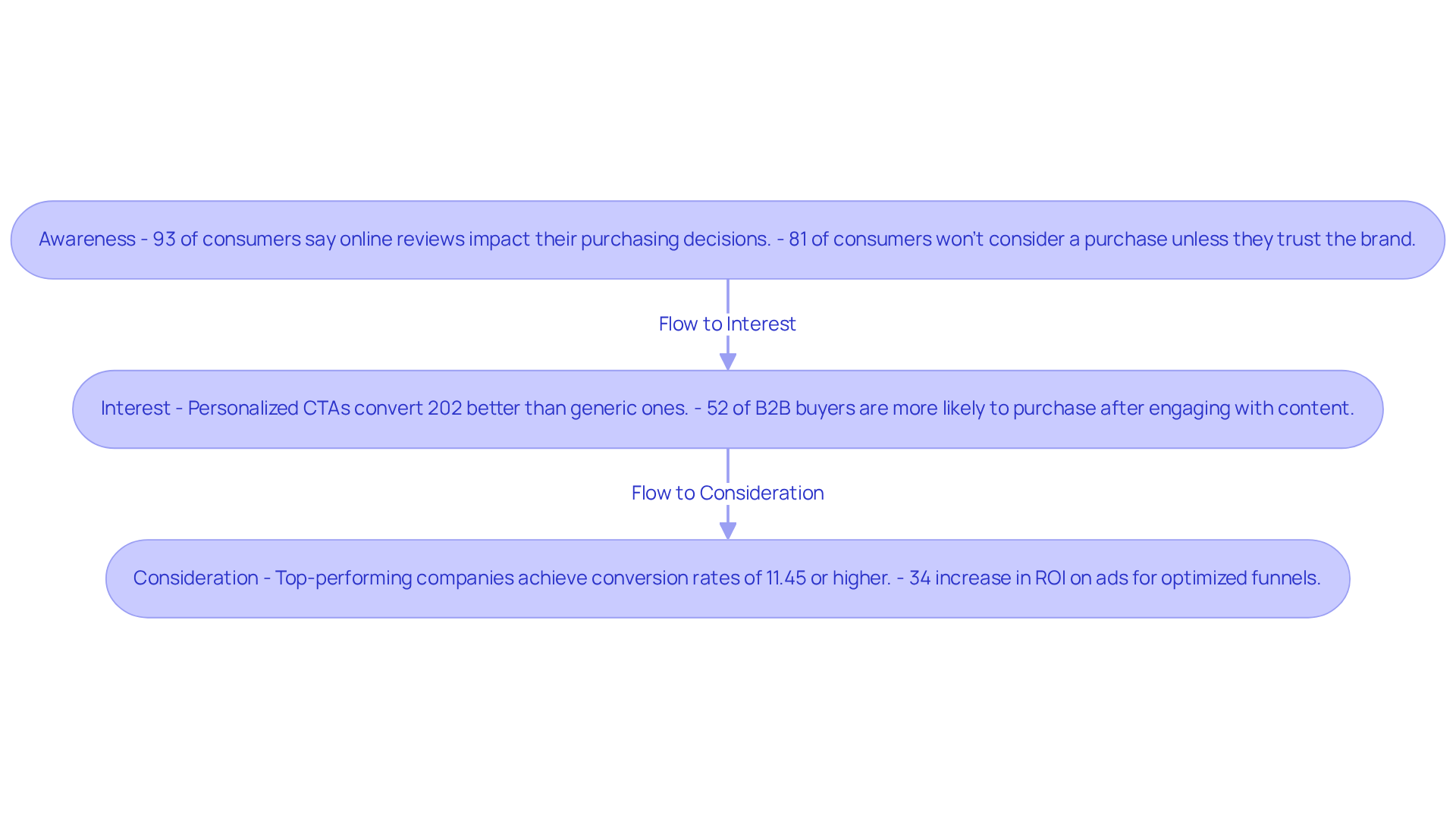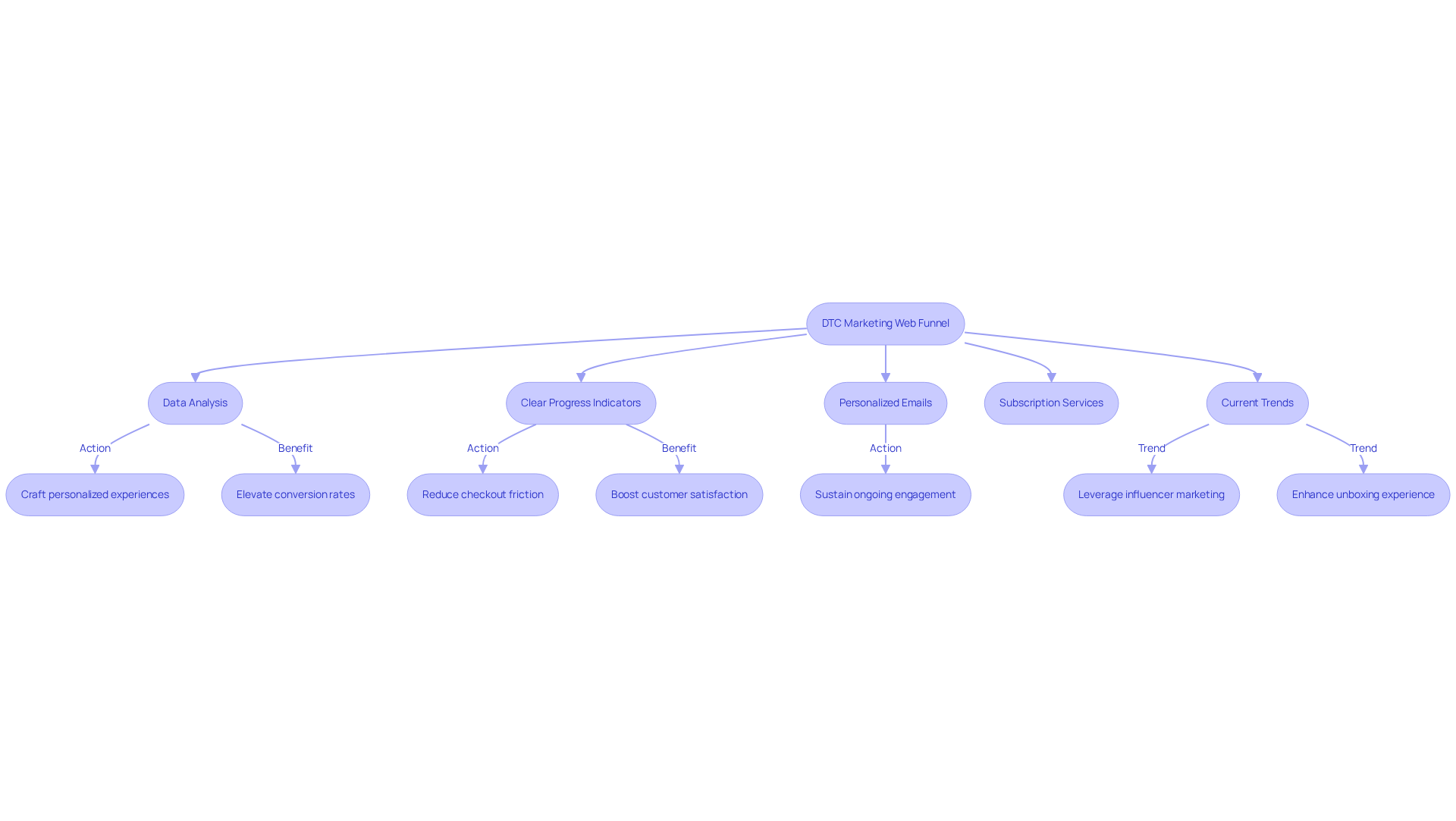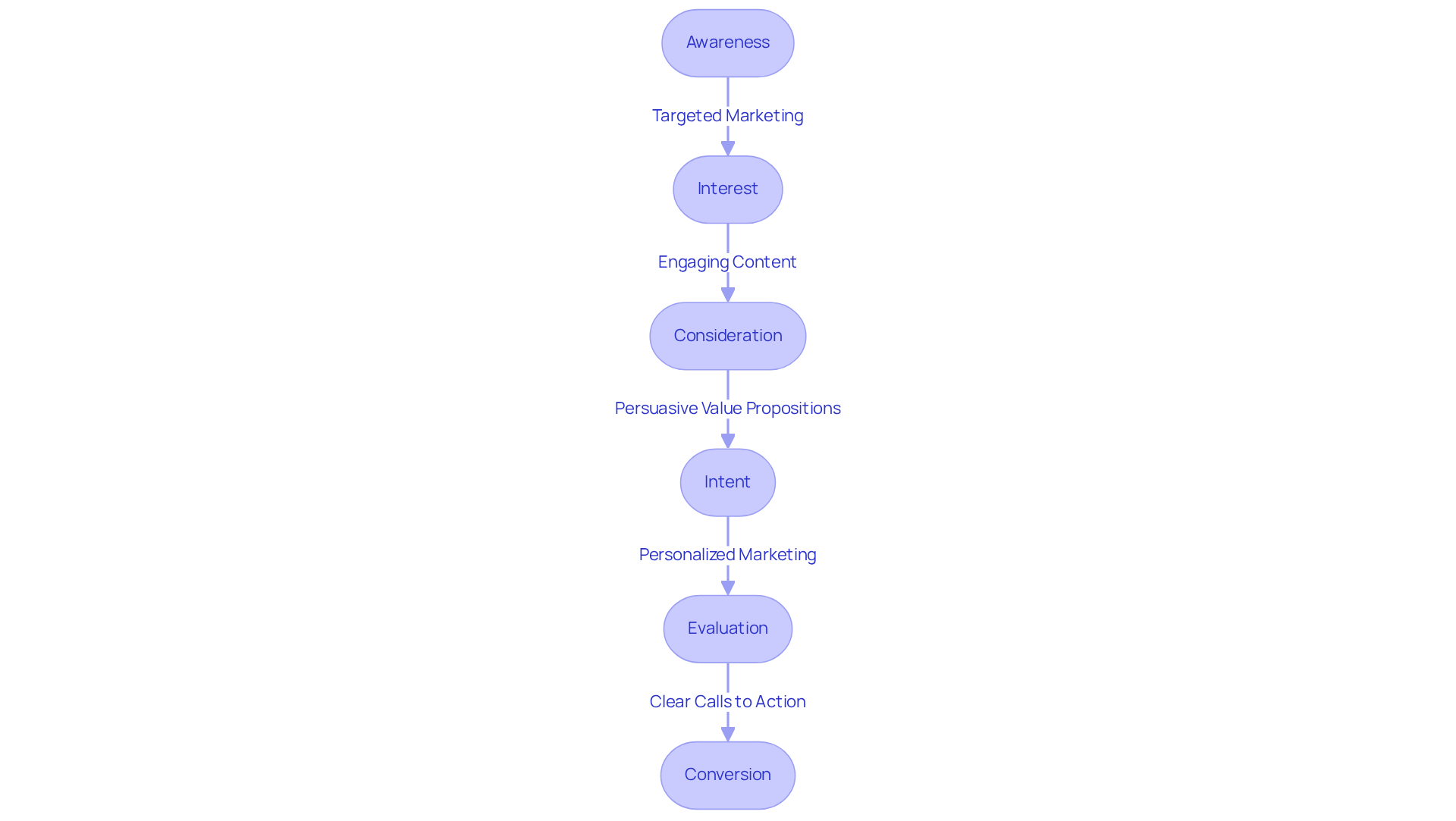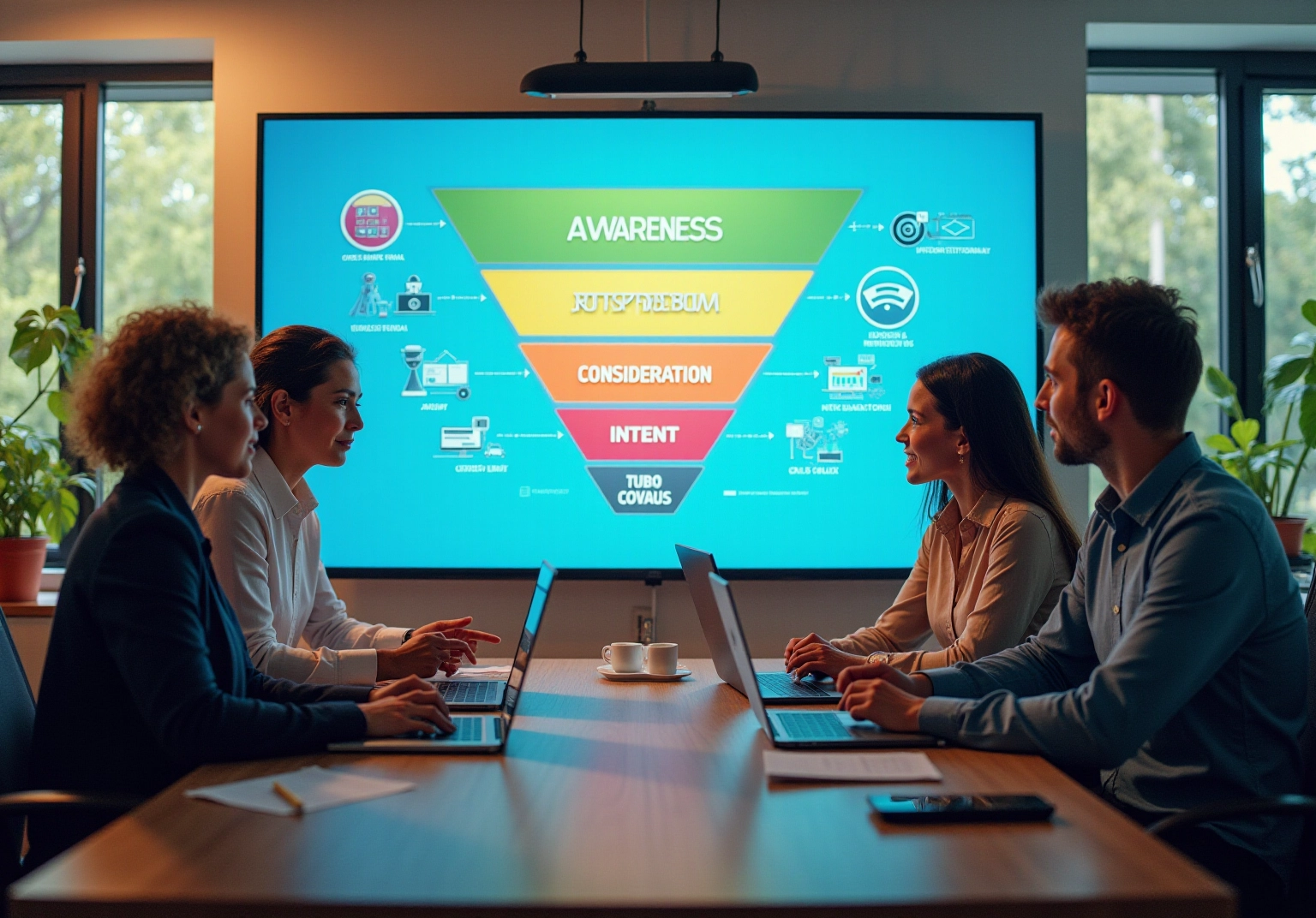
Overview
This article delves into the critical role of the web funnel in direct-to-consumer (DTC) marketing, underscoring its essential components and the importance of effectively guiding consumers through their buying journey. DTC brands must optimize each stage of the funnel—awareness, interest, consideration, intent, evaluation, and conversion. By employing targeted strategies such as personalized marketing and social proof, brands can significantly enhance conversion rates and cultivate lasting customer loyalty. Understanding and mastering this funnel is not merely advantageous; it is imperative for success in the increasingly competitive DTC landscape.
Introduction
The digital landscape has fundamentally transformed consumer interactions with brands, positioning the web funnel as an indispensable element of direct-to-consumer (DTC) marketing strategies. This framework meticulously maps the buyer's journey from initial awareness to final purchase, unveiling critical insights that significantly enhance conversion rates and bolster customer retention. Despite its potential, many businesses continue to underutilize this powerful tool. Thus, the pressing question emerges: how can DTC companies effectively leverage the web funnel to optimize their marketing efforts and ensure they capture every potential sale?
Define Web Funnel: A Comprehensive Overview
A web funnel, often referred to as a sales pipeline, visually illustrates the buyer's journey from initial awareness of a product or service to the final purchasing decision. This model delineates the distinct phases potential customers navigate, including:
- Awareness
- Interest
- Consideration
In the realm of direct-to-consumer (DTC) marketing, understanding the web funnel is paramount for effectively guiding consumers through their buying journey. By meticulously analyzing each phase of the web funnel, brands can identify areas for enhancement and refine their marketing strategies to elevate success rates and average order values (AOV).
Current trends reveal that nearly 570,000 websites are employing sales pipeline tools to optimize their processes, signifying a growing acknowledgment of structured management. Nevertheless, only 34% of businesses consistently refine their sales process, presenting a significant opportunity for improvement in success rates. The average transformation rate across sectors hovers around 2.35%, while e-commerce specifically experiences an average transformation rate of approximately 2.03%. Top-performing companies achieve rates of 11.45% or higher. For DTC companies, focusing on the web funnel in the online sales process not only bolsters transaction rates but also enhances client retention, as existing clients typically spend considerably more than new ones.
Effective sales strategies for DTC companies encompass the use of personalized calls to action (CTAs), which yield 202% higher effectiveness than standard CTAs, alongside optimizing for mobile, given that mobile accounts for 68% of e-commerce traffic, despite its average success rate being merely 2%. Furthermore, integrating social proof, such as client testimonials, can amplify conversions by as much as 34%. By embracing these strategies, companies can cultivate a more efficient web funnel that drives sales and fosters enduring loyalty among clients.

Contextualize the Web Funnel in DTC Marketing
In the realm of DTC marketing, the online pathway is paramount for enhancing client experiences and driving sales. By selling directly to consumers, DTC companies exercise unparalleled control over the consumer journey, allowing them to customize their marketing strategies to align with the distinct needs and behaviors of their audience.
Through data analysis and insights derived from consumer behavior, these companies craft personalized experiences that effectively navigate prospective clients through the web funnel, culminating in elevated conversion rates. This tailored approach is indispensable in today's competitive landscape, where escalating client acquisition costs necessitate the optimization of existing resources.
For instance, organizations are increasingly implementing strategies such as:
- Clear progress indicators during checkout
- Personalized cart abandonment emails
These strategies not only alleviate friction but also boost customer satisfaction. Email marketing remains the primary driver of repeat purchases for companies, underscoring the importance for DTC brands to leverage tools like Klaviyo for automated email marketing.
Furthermore, integrating subscription services into their strategies enables DTC companies to sustain ongoing engagement and catalyze repeat purchases, thereby fortifying their market standing. As the DTC sector evolves, staying attuned to current trends—such as the integration of influencer marketing and the pivotal role of the unboxing experience in creating memorable moments—will be essential for brands aiming to refine their online pathways and elevate overall customer experiences.

Trace the Evolution of Web Funnels in Marketing
The evolution of the web channel represents a significant shift in marketing dynamics. Initially, sales processes were predominantly linear, focusing on a straightforward journey from awareness to purchase. However, the rise of digital marketing and e-commerce has transformed the online sales landscape into a complex and dynamic ecosystem. Today, this process encompasses multiple touchpoints—social media, email marketing, and online advertising—mirroring the varied ways consumers now engage with brands. Establishing trust at every stage of the marketing process is paramount, as it fosters stronger connections that ultimately lead to conversions.
Data analytics has emerged as a powerful tool, allowing marketers to monitor consumer behavior with precision. This capability has given rise to advanced strategies that prioritize personalization and engagement. Such evolution highlights the necessity of adapting marketing tactics to align with the expectations of modern consumers, particularly in the Direct-to-Consumer (DTC) space. Furthermore, collaboration between marketing and sales teams during the evaluation stage is critical for persuading customers of a product's superiority.
As mobile optimization becomes increasingly crucial due to the decline in desktop shopping, DTC companies must ensure their pathways are meticulously tailored for mobile users. The concept of a 'leaky pipeline,' where potential opportunities exit the process, underscores the urgent need for strategic adjustments to retain leads. Understanding and refining these intricate web funnels will be essential for brands aiming to enhance user experiences and drive sales.
![]()
Identify Key Components and Characteristics of Web Funnels
The web funnel is made up of several key components: awareness, interest, consideration, intent, evaluation, and conversion. Each stage is crucial in guiding potential buyers toward making a purchase. In the awareness stage, companies attract interest through targeted marketing efforts, employing strategies such as social media campaigns and SEO to reach a wider audience. The interest stage captivates consumers with compelling content, including informative blog posts and eye-catching visuals, which foster a connection with the audience.
During the consideration phase, potential clients evaluate their options, making it essential for brands to provide clear information and persuasive value propositions. This includes detailed product descriptions, comparison charts, and customer testimonials that bolster credibility. As prospects advance into the intent and evaluation phases, they refine their decision-making process, often influenced by personalized marketing strategies like retargeted advertisements, which can boost success rates by 147%, and customized email campaigns.
Understanding these elements enables DTC brands to implement targeted strategies at every stage of the process. For example, integrating video content in the middle of the funnel can enhance success rates by 66%, while strategically positioning testimonials throughout the funnel can increase engagement rates by 34%. Moreover, each page should feature a single call to action and proposition to ensure clarity in converting visitors into customers. By optimizing each phase of the customer journey and utilizing a web funnel through ongoing A/B testing and tracking conversions, brands can improve the overall effectiveness of their marketing efforts, ultimately driving profitable growth.

Conclusion
The exploration of the web funnel underscores its critical role in direct-to-consumer (DTC) marketing, acting as a strategic roadmap that navigates potential buyers from initial awareness to final purchase. By comprehensively understanding and optimizing each stage of this funnel, brands can significantly elevate their marketing strategies, ultimately resulting in enhanced conversion rates and increased customer loyalty.
Key insights throughout this article emphasize the necessity of:
- Personalization
- Mobile optimization
- Integration of social proof within the web funnel
Implementing strategies such as:
- Personalized calls to action
- Effective email marketing
- Clear progress indicators during the purchasing process
is essential for minimizing friction and cultivating positive customer experiences. Furthermore, the evolution of web funnels highlights the imperative for brands to adapt to the dynamic digital landscape, ensuring they meet the expectations of contemporary consumers.
In light of these findings, DTC brands are urged to proactively refine their web funnel strategies. By harnessing data analytics and adopting innovative marketing tactics, companies can enhance user experiences while simultaneously driving sustainable growth in an increasingly competitive market. The importance of mastering the web funnel cannot be overstated; it is a fundamental element in establishing enduring connections with consumers and achieving long-term success within the DTC arena.
Frequently Asked Questions
What is a web funnel?
A web funnel, also known as a sales pipeline, visually illustrates the buyer's journey from initial awareness of a product or service to the final purchasing decision, highlighting the distinct phases potential customers navigate.
What are the key phases of a web funnel?
The key phases of a web funnel include Awareness, Interest, and Consideration.
Why is understanding the web funnel important for direct-to-consumer (DTC) marketing?
Understanding the web funnel is crucial for effectively guiding consumers through their buying journey, allowing brands to identify areas for enhancement and refine their marketing strategies to improve success rates and average order values (AOV).
How many websites are currently using sales pipeline tools?
Nearly 570,000 websites are employing sales pipeline tools to optimize their processes.
What percentage of businesses consistently refine their sales process?
Only 34% of businesses consistently refine their sales process, indicating a significant opportunity for improvement.
What are the average transformation rates across sectors and for e-commerce specifically?
The average transformation rate across sectors is around 2.35%, while e-commerce specifically has an average transformation rate of approximately 2.03%. Top-performing companies achieve rates of 11.45% or higher.
How does focusing on the web funnel benefit DTC companies?
Focusing on the web funnel enhances transaction rates and client retention, as existing clients typically spend considerably more than new ones.
What sales strategies are effective for DTC companies?
Effective sales strategies for DTC companies include using personalized calls to action (CTAs) that are 202% more effective than standard CTAs, optimizing for mobile, and integrating social proof like client testimonials to amplify conversions by as much as 34%.
What percentage of e-commerce traffic comes from mobile devices?
Mobile accounts for 68% of e-commerce traffic, although its average success rate is only 2%.
FAQs











